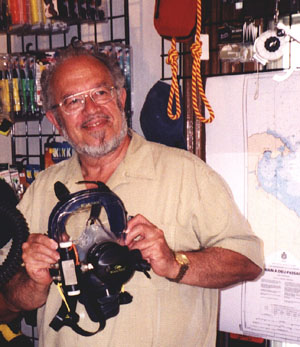I was first introduced to Alex Storm through his book, Seaweed and Gold. It was a great tale of shipwreck hunting in, of all places, Cape Breton Island, in Nova Scotia. Alex told the tale of how he searched for, and found, Le Chameau, a French Pay Ship, that have the full payroll of the French garrisons in the new world. The ship had been lost since 1725. Putting together clues, Alex and his team of amateur scuba divers began an adventure in 1961, which resulted in the locating of cannon and anchors and… gold!While the story of Le Chameau, the Feverham and other wrecks found by Storm are great stories, the real story is of the man himself. I met Alex Storm in 2003. After reading his book I wanted to meet the man. I called him on the phone and after a brief chat, was invited to drop in to his place in Louisbourg. I asked for directions and that was when I figured I was going to enjoy meeting him.

The conversation went like this:
Me: Is there an address for the house?
Alex: Yes, but it won’t help you cause my number sign is very small.
Me: So how will I find you?
Alex: Just come in on the main street and look for the fire station. I am the next house over. If you miss the fire station just look for the only three story white house on the street. And if that fails just look for the two cannon and two anchors on the front lawn!
Me: OK

I found the house and was welcomed by a tall grey-bearded man who spoke with a familiar accent. (Both my wife and Alex are of Dutch descent.) His wife, Emily, served us tea and left us to talk. And talk we did.
Alex Storm was born in 1937 on the Dutch Island of Java, now part of Indonesia. He led the carefree life of a boy for the first years but then tragedy struck. The Japanese took over Java and placed young Alex (aged four years) with his mother and sisters into a internment camp. His father was placed in a men’s camp and did not see the family until the end of the war. Life in the camp was harsh and food was scarce. Alex’s older sister died of starvation before the camp was liberated. When the family was reunited in 1945, they left Indonesia for the Netherlands, only to return in 1947. Alex, a free spirit, left the family in 1952 to go back to Holland to learn a trade.

When Alex turned 22, he received a message from a friend who had moved to Canada. “Come to Canada, Alex, the jobs are plentiful”. So off he went to Toronto. He eventually left Toronto for Sydney, Nova Scotia where he worked as a metal man in a ship yard. In 1961, the federal government had resolved to rebuild the Louisbourg (also spelled Louisburg) Fort nearby Sydney. Always one for a challenge, Alex joined the construction team and eventually became responsible for all the artifacts at the Fort.
Alex still lives in the house with the cannon and anchors. Unfortunately his wife of 47 years, Emily, passed away in 2011. She is remembered by Alex and their five children.
If you are interested in treasure hunting I recommend you pick up Alex’s book (see below). Pages 165-185 of the book are focused on the search for the Louisbourg Treasure, still not found. Alex gives you all the clues. It is up to you to look for the millions in gold and silver! Better do it before I do.
Will O'Connell
Looking for info on st.michel sunken near point machaud
Donna Muise
There is a book in which the boat ‘The MUSEHEDD’ is mentioned. Once when Alex Storm was trying to avoid hitting the rocks when a storm came up, the MUSEHEDD came to his rescue and towed him safely into the harbor. The MUSEHEDD was owned by my father-in-law Joseph Muise. Can you tell me which book this information is in.
Bruce
Look in the Beaton Institute and the Cape Breton College for information on the St Michael.
rick mcintyre
info on st michel sunk around 1750 please near pt michaud
rick mcintyre
i am waiting for info on st michell sunk in point michaud in 1745.
rick mcintyre
where can i get info on st. michel sunk in 1745 near point michaud. thank you very much
rick mcintyre
st.michel 1745 near point michaud sunk please send info